'Untold: Patriots Revealed' uncovers unsung heroes of American Revolution
Pete Hegseth hosts new Fox Nation special 'Untold: Patriots Revealed.'
The founding of the United States was shaped by inspirational figures authoring remarkable tales long since forgotten — or since erased.
Tamanend is one of them.
More commonly called King Tammany, or Saint Tammany, he was a 17th-century Lenni Lenape (Delaware) chief who found a friend and ally in English Quaker William Penn — who settled the region in 1682.
Tammany was revered as the "Patron Saint of America" by the generation of the Founding Fathers and the patriots who fought, bled and died for the cause of American independence.
"The Pennsylvania troops under Washington’s command were the first to raise their banners on which were inscribed ‘St. Tamanend,'" Leon Nelson Nichols wrote in 1892 in "The History of Tammany," which chronicles both the life of the man and the influential patriotic Tammany societies he inspired around the new nation.
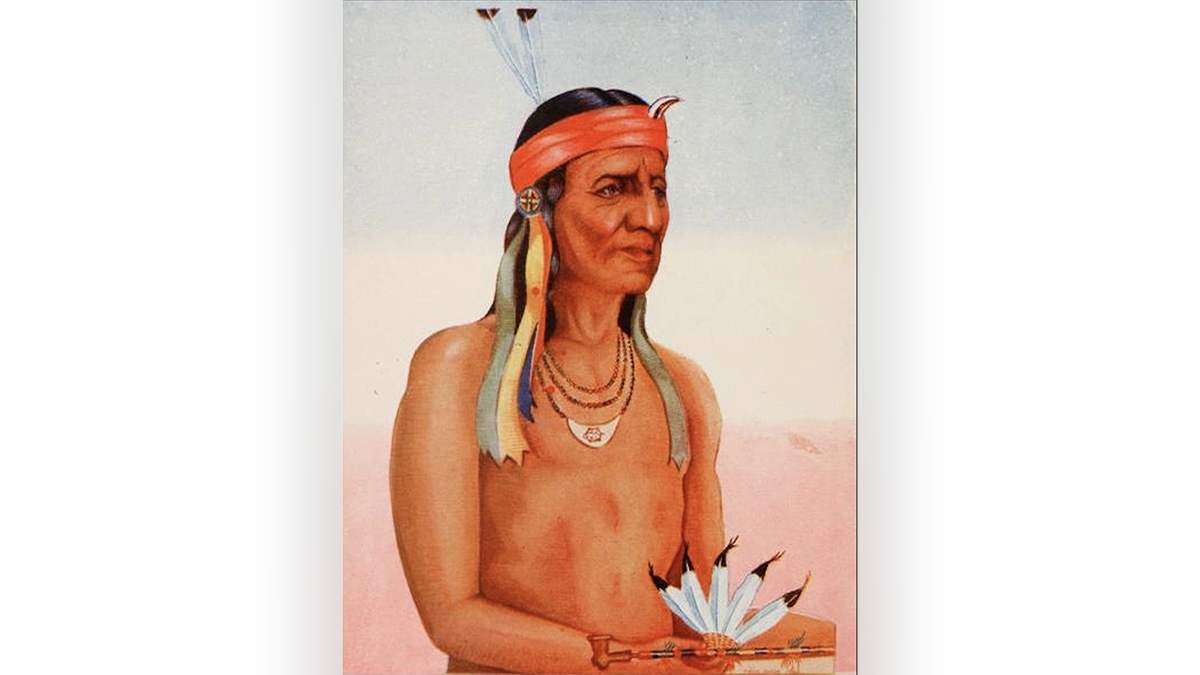
Lenni Lenape chief Tammany was dubbed the "Patron Saint of America" by the generation that fought for American independence. This is an idealized composite portrait by Fritz Bade from descriptions of the man, as featured in the 1938 book, "The Tammany Legend" by Joseph White Norwood. (Fritz Bade/Public Domain)
Nichols added, "Soon other troops caught the zeal for Saint Tamanend until at last the whole American army had adopted the chief as its patron saint."
"Tamanend … played a prominent role in the establishment of peaceful relations among the Native American tribes and the English settlers who established Pennsylvania," reports DelawareTribe.org, the official website of the Delaware tribe of Indians.
"This is King Tammany’s Day … The People here have sainted him and keep his day." — John Adams
He was feted each May, most notably in the Mid-Atlantic states.
"This is King Tammany’s Day … The People here have sainted him and keep his day," John Adams wrote from Philadelphia to future first lady Abigail back in Boston on May 1, 1777.
"It was as important a day as the Fourth of July," wrote Nichols.
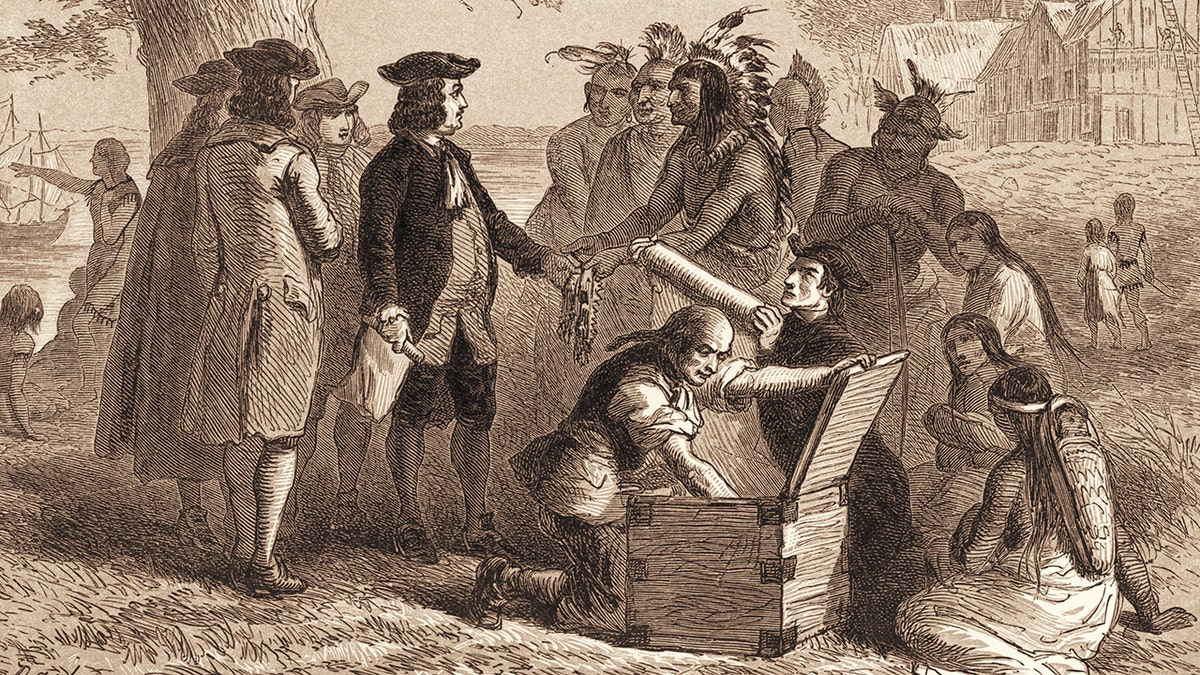
British statesman William Penn (1644-1718) (in dark coat) accepts a belt from Tamanend (1628-1698), chief of the Lenni Lenape Indians, as part of the treaty in which Penn purchased a section of land for the Pennsylvania Colony, Kensington, Philadelphia, Pennsylvania, 1682. (Stock Montage/Getty Images)
"While the army held its celebrations on May 12, one Philadelphia Tammany society, at least, celebrated on May 1."
The "men spent the day in mirth and jollity ... in honor of King Tammany," an aide to George Washington wrote from Valley Forge in May 1778.
MEET THE AMERICAN WHO ROWED WASHINGTON ACROSS THE DELAWARE ON CHRISTMAS: SAILOR-SOLDIER JOHN GLOVER
"It was during the Revolutionary War when stories of a patriotic and wise Indian chief had become circulated through the Colonies and had taken a strong hold upon the minds of the soldiers," Nichols wrote.
After inspiring American patriots in the 18th century, Tammany shaped American politics in the 19th century and was celebrated in American popular culture well into the 20th century, most notably on the uniforms of professional sports teams.
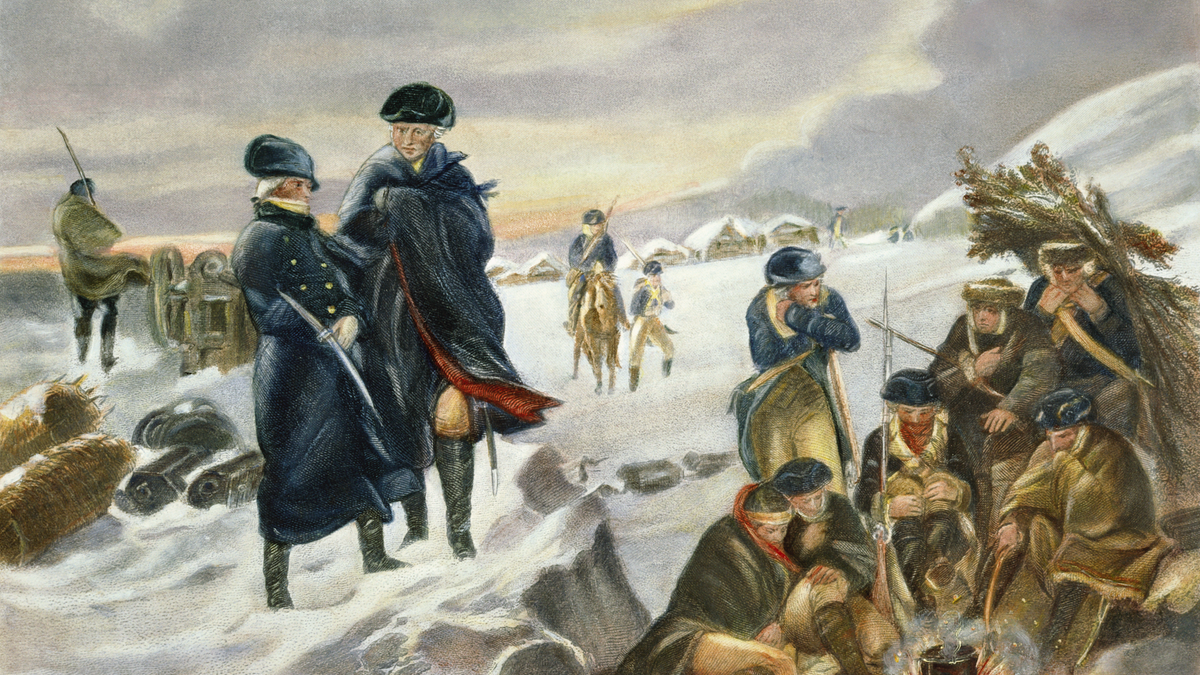
George Washington meets with Marquis Lafayette at Valley Forge, winter 1777-78. After the brutal winter of death, disease and hunger, Washington's men at Valley Forge joyously celebrated King Tammany Day in May 1778. (Painting by Alonzo Chappel/Getty Images)
The first original American opera, "Tammany: the Indian Chief," was performed at John Street Theater in Manhattan in 1794.
Tammany appears in James Fenimore Cooper’s classic 1826 American novel, "The Last of the Mohicans."
"Soon other troops caught the zeal for Saint Tamanend until at last the whole American army had adopted the chief as its patron saint."
A statue of Tammany keeps watch over the campus of the United States Naval Academy in Annapolis, Maryland.
Another Tammany statue enjoys a place of prestige in Old City Philadelphia at the corner of Front and Market streets, a few blocks east of Independence Hall and the Liberty Bell.
Tammany also serves as a silent sentinel to the heroes of Gettysburg.

The 42 New York Volunteer Infantry Regiment was commonly known as The Tammany Regiment, in honor of the Lenni Lenape chief who helped inspire the birth of the new nation. Tammany's image adorns the battlefield monument at Gettysburg, where the 42nd New York Volunteers fought bravely during the Civil War. (Library of Congress/public domain)
New York’s 42nd Volunteer Infantry Regiment — the Tammany Regiment — fought heroically on the infamous Pennsylvania battlefield upon which the course of American history turned.
The image of Tammany stands atop a monument to these men who helped defeat slavery.
Tammany became a model of aspiration after the American Revolution. Patriotic Tammany societies proliferated around the nation.
MEET THE AMERICAN WHO FOUGHT AND BLED AT THE ALAMO BUT LIVED TO TELL ITS HEROIC TALE: SLAVE JOE
"This institution shall be called and known by the name of ‘Tammany Society, or Columbian Order,’" reads one Tammany Society Constitution of 1790.
"It shall connect in the indissoluble bonds of Patriots Friendship, American Brethren of known attachment to the Political Rights of Human Nature, and the Liberties of this Country."
Yes, Tammany, like Columbia in an earlier United States, was viewed as a personification of the ideal of human liberty.

A statue of King Tammany, dubbed "the Patron Saint of America," stands on the campus of the U.S. Naval Academy in Annapolis, Maryland. (Public Domain)
Tammany Hall, the powerful Democrat Party machine of Boss Tweed fame that ruled New York City for decades, was one of those organizations named in his honor.
Tammany Hall’s Manhattan office in Union Square featured a statue of Tamanend over the entrance.
Tammany’s likeness above Tammany Hall appears in the 2002 movie "Gangs of New York."
HAUNTING PRISON SHIP MARTYS MONUMENT IN BROOKLYN IS AMERICA'S ‘ORIGINAL’ TOMB OF UNKNOWN WAR HEROES
It was through James Gaffney, a Democrat operative from Tammany Hall in New York City, that the image of King Tammany entered American professional sports.
He purchased the Boston Rustlers of the baseball's National League in 1912.
Gaffney quickly renamed the team the Boston Braves in honor of King Tammany and his own Tammany Hall. He added the image of the inspirational Lenni Lenape to the team's uniforms.

Tammany Hall located at West 14th St. Union Square New York City, 1914. Boss Tweed commissioned the creation of this new hall after gaining influence and affluence in New York City. This building was built in 1867 and demolished in 1927. (Courtesy Library of Congress)
Babe Ruth played for the Boston Braves in 1935, the final season of his career. The American icon last played wearing not Yankees pinstripes, but the face of the Patron Saint of America on his sleeve.
The image inspired by Tammany later adorned Braves uniforms as the franchise moved to Milwaukee and Atlanta.
The Atlanta Braves, bowing to pressure from a nation that had forgotten its history, removed the image inspired by King Tammany from their uniforms in 1989.
The Patron Saint of America had become the victim of cancel culture for the first time. But not the last time.
Under attack in later years
Businessman George Preston Marshall brought the National Football League to Boston in 1932.
As was the custom of the era, he named the upstart pro football club after the more established local pro baseball team.

Playing with the Boston Braves, Babe Ruth signs autographs for fans at the New York Giants' home opener against the Braves at the Polo Grounds, New York, April 23, 1935. The Boston Braves were founded by James Gaffney, a member of Tammany Hall, who adopted the image of Lenni Lenape chief King Tammany as the team logo — seen on Ruth's left sleeve. (Getty Images)
Marshall's Boston Football Braves adopted the same primary red color scheme and logo as the Boston Baseball Braves. The football team even played at Braves Field in Boston.
King Tammany had entered the imagery of the NFL.
But Marshall’s deal at Braves Field lasted only one year. He moved the team to nearby Fenway Park the following year — home of the American League Boston Red Sox.
The Braves team needed a new name. Boston Red Sox. Boston Redskins. It was simple as that.
The new name honored tradition, history and patriotism — and was consistent with his existing red color scheme, while paying tribute to the host organization.

The USS Delaware, a 74-gun ship of the line built for the U.S. Navy in 1820, was fitted out with a figurehead of Lenni Lenapi chief Tamanend. The wooden figurehead was donated to the U.S. Naval Academy in 1866. Its image was later turned into a statue on the academy campus. Often mistakenly called Tecumseh, it is actually Tamanend, according to the U.S. Naval Academy Public Affairs Office.
The Boston Redskins played at the home of the Boston Red Sox from 1933 to 1936. Marshall moved the franchise to Washington D.C. in 1937. The name Redskins and the proud Tammany logo went with him.
Marshall died in 1969. The team freshened its logo in 1971.
The new version was designed by Blackfeet native Walter "Blackie" Wetzel — with input and approval from Native American groups.
The new Native American logo adorned the side of Washington Redskins helmets starting in 1972.
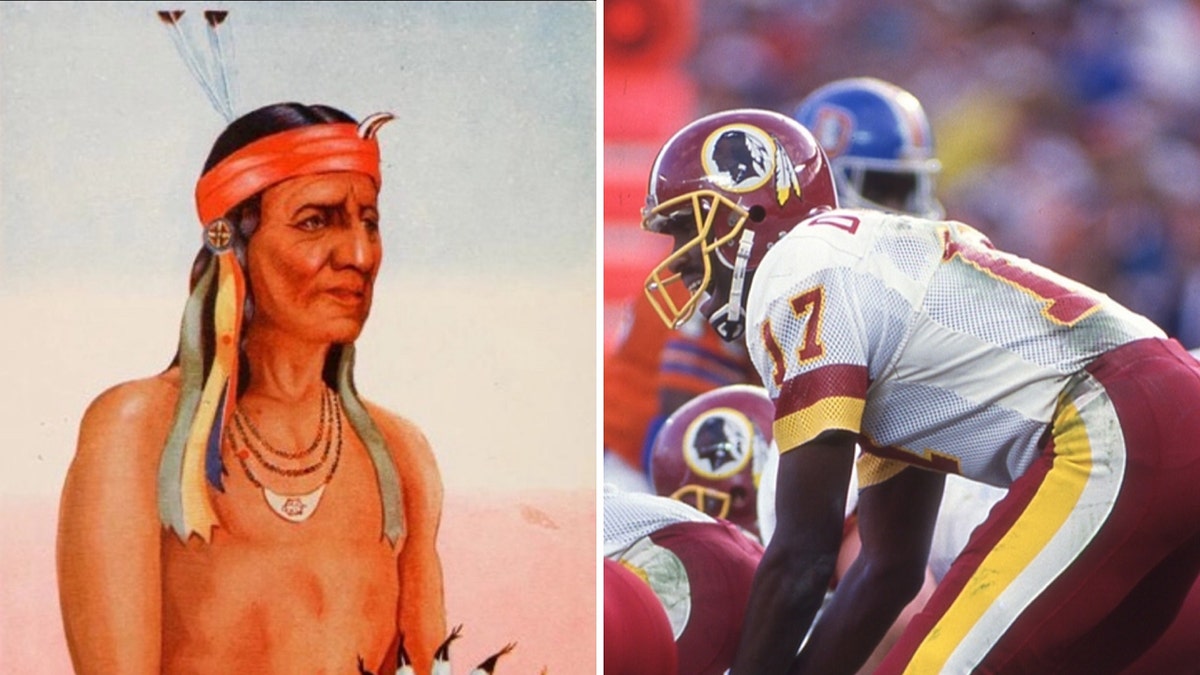
King Tammany, left, in an early 19th-century portrait by Fritz Bade in the 1938 book, "The Tammany Legend" by Joseph White Norwood. Doug Williams, right, during his time as a quarterback in the late 1980s with the Washington Redskins (now the Washington Commanders). The Redskins logo was inspired by King Tammany, beloved by earlier generations of Americans. (Fritz Bade/Public Domain; Owen C. Shaw/Getty Images)
The logo was reportedly meant to be an image of Blackfeet Chief John Two Guns White Calf.
But it bore a striking resemblance to the only known portrait of Tamanend: same distinctive large nose, same white feathers with black tips, same long black hair pulled tightly into a braid, similar head dress trussed to the hair.
The Redskins bowed to pressure from a public that no longer cared about or knew about the nation's rich multicultural heritage.
Yet this tribute to the Patron Saint of America came under attack in later years.
Tammany was canceled again in 2020. The Redskins bowed to pressure from a public that no longer cared about or knew about the nation's rich multicultural heritage.
FOX NATION'S ‘UNCANCELLING COLUMBUS’ EXPLORES LEFT'S EFFORT TO WARP CHRISTOPHER COLUMBUS' LEGACY
The organization ditched the proud image inspired by King Tammany.
The team that took the field for nearly 80 years in celebration of the Patron Saint of America was renamed the generic Washington Commanders in 2022.
Marshall, dead and unable to defend himself, was labeled a racist in the process to rewrite history.
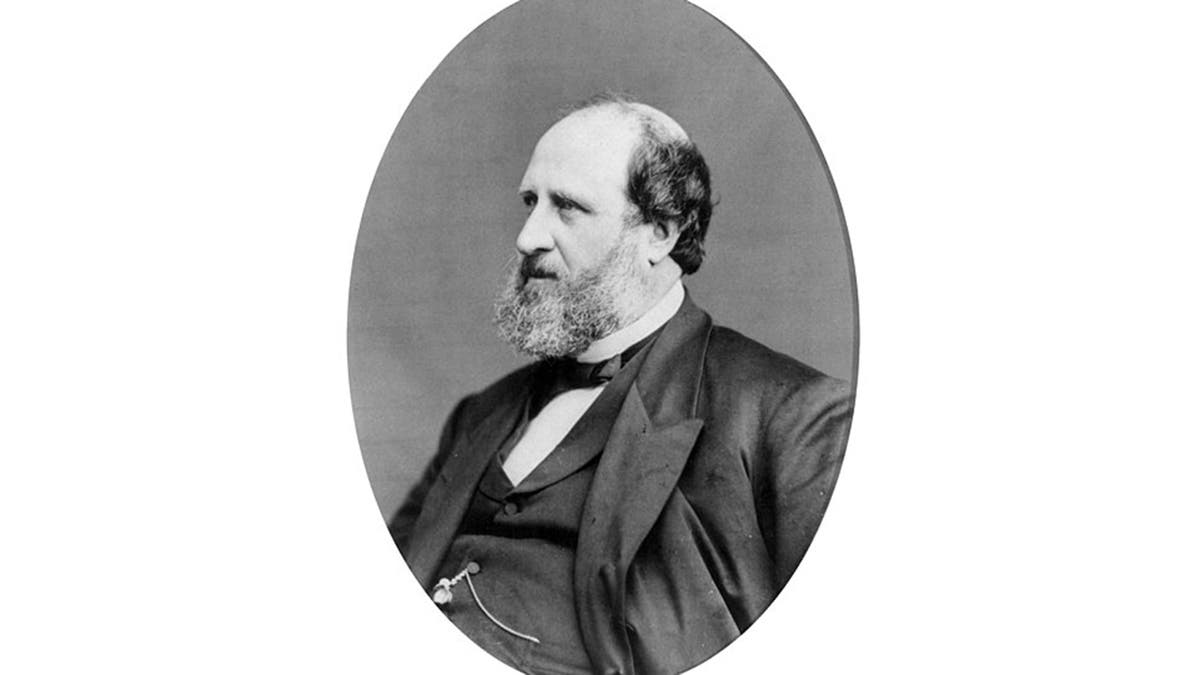
William Marcy "Boss" Tweed (1823-1878) ran Tammany Hall in New York City. Originally a patriotic society named for Lenni Lenape chief King Tammany, it devolved into a Democrat political machine, which Tweed used to line the pockets of himself and his friends. (Hoxie Collection, Public Domain)
The reality is that Marshall had nothing to do with concocting native imagery for nefarious purposes. Instead, he inherited the celebratory image of the beloved Patron Saint of America from James Gaffney and the Democrats of Tammany Hall in New York City.
The name Redskins wasn't some evil invective of a raving racist. It was an alliterative tribute to the Boston Red Sox, a clever name that allowed Marshall to keep alive the imagery of beloved King Tammany.
But in the decades after Marshall died, a simplistic new binary narrative of American history had emerged.
"Zinn falsified the history of natives. He was a fiction writer, not a historian." — Mary Grabar
Indigenous people were only victims and Europeans were only rapacious invaders in this new version of history, crafted most notably by influential Marxist historian Howard Zinn.
His simplistic narrative has since been popularized and proselytized by zealots in academia.
"Zinn falsified the history of natives," Mary Grabar, the author of "Debunking Howard Zinn," told Fox News Digital.
CLICK HERE TO SIGN UP FOR OUR LIFESTYLE NEWSLETTER
"He was a fiction writer, not a historian," said Grabar, a fellow with the Alexander Hamilton Institute in Clinton, New York.
Zinn does not mention Tammany in his influential 1980 attack on American history, "The People's History of the United States."
The real historical narrative of King Tammany appears too complex and nuanced to fit the modern cancel-culture narrative.
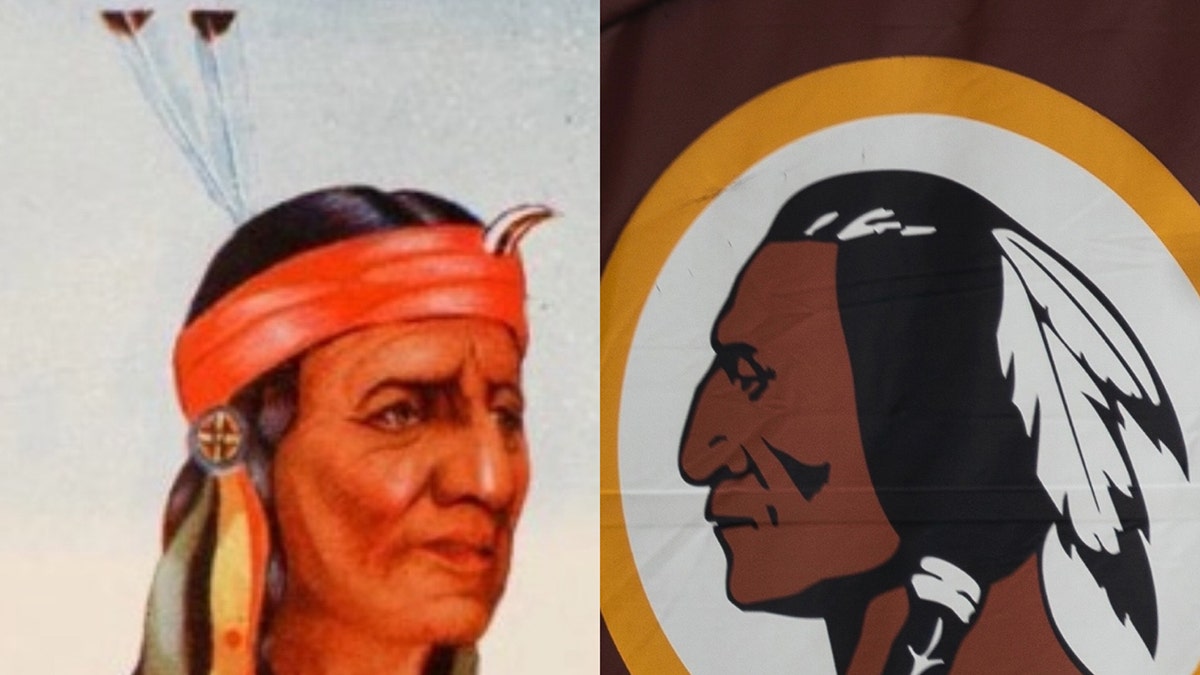
King Tammany, left, as he appears in an early 19th-century portrait by Fritz Bade in the 1938 book, "The Tammany Legend" by Joseph White Norwood. On right, logo of the former Washington Redskins, now the Washington Commanders, of the NFL. The Redskins imagery and logo were originally inspired by King Tammany in the 1930s. (Public Domain/Getty Images)
In reality, a Lenni Lenape chief shaped 200 years of American history — and was celebrated as the Patron Saint of the new nation.
King Tammany has since been forgotten at best, purposely erased at worst.
"The American ideals of human right to ‘life, liberty and the pursuit of happiness’ spring chiefly from original American sources and were developed on American soil for untold centuries before Europeans arrived on this continent," historian and biographer of early Americans Joseph White Norwood wrote in his 1938 book "The Tammany Legend."
CLICK HERE TO GET THE FOX NEWS APP
"These ideals are therefore so distinctively native to the soil that they should be known as the first Americans knew them, by a name that completely symbolizes them. This name is Tamanend."
To read more stories in this unique "Meet the American Who…" series from Fox News Digital, click here.


